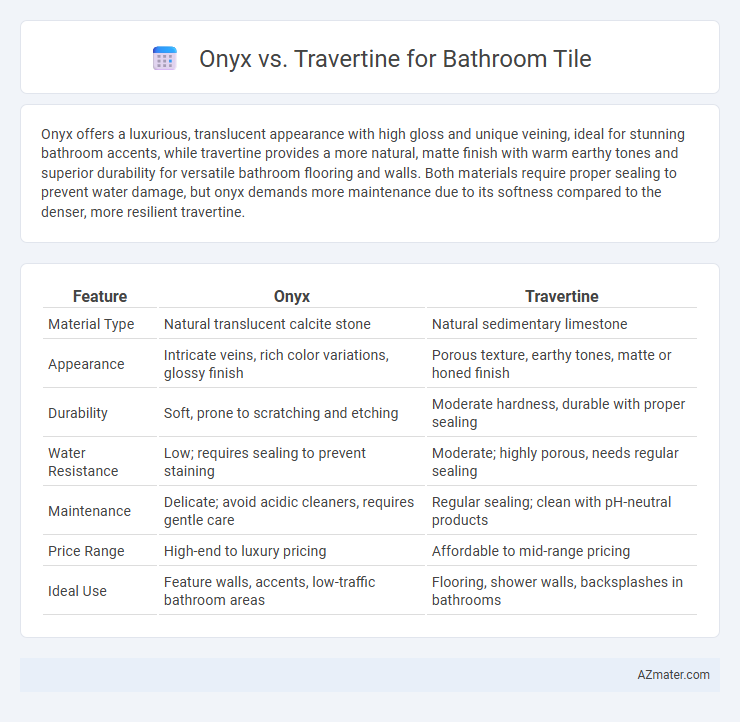Onyx offers a luxurious, translucent appearance with high gloss and unique veining, ideal for stunning bathroom accents, while travertine provides a more natural, matte finish with warm earthy tones and superior durability for versatile bathroom flooring and walls. Both materials require proper sealing to prevent water damage, but onyx demands more maintenance due to its softness compared to the denser, more resilient travertine.
Table of Comparison
| Feature | Onyx | Travertine |
|---|---|---|
| Material Type | Natural translucent calcite stone | Natural sedimentary limestone |
| Appearance | Intricate veins, rich color variations, glossy finish | Porous texture, earthy tones, matte or honed finish |
| Durability | Soft, prone to scratching and etching | Moderate hardness, durable with proper sealing |
| Water Resistance | Low; requires sealing to prevent staining | Moderate; highly porous, needs regular sealing |
| Maintenance | Delicate; avoid acidic cleaners, requires gentle care | Regular sealing; clean with pH-neutral products |
| Price Range | High-end to luxury pricing | Affordable to mid-range pricing |
| Ideal Use | Feature walls, accents, low-traffic bathroom areas | Flooring, shower walls, backsplashes in bathrooms |
Introduction: Onyx vs Travertine Bathroom Tiles
Onyx and travertine are popular choices for bathroom tiles, each offering distinctive aesthetic and functional qualities. Onyx features a translucent, smooth surface with dramatic veining, providing a luxurious and unique visual appeal ideal for statement walls or accent pieces. Travertine, a form of limestone, is known for its porous texture and natural matte finish, offering durability and a warm, earthy ambiance well-suited for floors and shower areas.
Aesthetic Appeal: Visual Differences
Onyx offers a luxurious, translucent appearance with unique veining patterns that create a dramatic, high-end look in bathroom tile applications. Travertine features a more rustic, matte finish with natural pockmarks and warm, earthy tones that provide a classic, timeless aesthetic. The visual differences between onyx and travertine largely influence the overall bathroom design, with onyx suited for contemporary elegance and travertine ideal for traditional or Mediterranean styles.
Durability and Longevity
Onyx tiles offer exquisite translucency but are softer and more prone to scratching and etching compared to travertine, making them less durable for high-traffic bathroom areas. Travertine, a dense and more porous natural stone, withstands daily wear and moisture better when properly sealed, providing enhanced longevity in bathroom applications. Regular maintenance and sealing extend the lifespan of both materials, but travertine generally offers more robust durability and sustained performance over time.
Water and Stain Resistance
Onyx offers moderate water resistance but is more porous, making it susceptible to staining without proper sealing and maintenance. Travertine features natural pits and voids that increase its porosity, requiring sealing to enhance water and stain resistance in bathroom environments. Regular sealing and prompt cleaning are essential for both materials to maintain durability against moisture and stains in high-humidity areas.
Maintenance and Cleaning Requirements
Onyx bathroom tiles require regular sealing to prevent staining and etching due to their porous nature, and cleaning should be done with pH-neutral cleaners to avoid damage. Travertine tiles also need sealing but are more prone to surface pitting and erosion, necessitating gentle cleaning methods and avoidance of acidic or abrasive substances. Both materials demand careful upkeep, but onyx generally requires more frequent maintenance to preserve its polished appearance.
Installation Considerations
Onyx bathroom tiles require careful handling due to their natural translucency and higher fragility, making professional installation essential to avoid cracking or chipping. Travertine tiles, being more durable and less brittle, allow for easier cutting and fitting, often suitable for DIY enthusiasts with proper tools. Both materials benefit from a stable, well-prepared substrate and waterproofing measures to ensure longevity and prevent moisture damage in bathroom environments.
Cost Comparison: Onyx vs Travertine
Onyx bathroom tiles typically cost between $15 to $30 per square foot, making them a premium choice due to their unique translucency and luxurious appearance. Travertine tiles are generally more affordable, ranging from $3 to $10 per square foot, offering a classic and natural stone look. Installation costs for onyx are also higher because of its fragility, while travertine is easier to work with, resulting in lower labor expenses.
Slip Resistance and Bathroom Safety
Onyx and travertine tiles differ significantly in slip resistance, with travertine offering better grip due to its naturally porous and textured surface, reducing the risk of slips in bathroom environments. Onyx tiles, though visually striking with their translucent qualities, tend to have a smoother and more polished finish that can become slippery when wet, impacting bathroom safety negatively. Selecting travertine for bathroom flooring enhances safety by providing increased traction, making it a more practical choice for wet and humid areas.
Design Versatility and Color Options
Onyx offers exceptional translucency and a luxurious, glossy finish that enhances bathroom tile designs with a striking, luminous appeal. Travertine provides a more natural, earthy aesthetic with matte textures and warm, neutral tones, making it highly versatile for rustic or classic bathroom themes. Both materials support diverse color palettes, yet onyx stands out for vibrant, dramatic hues, while travertine excels in subtle, timeless shades.
Environmental Impact and Sustainability
Onyx and travertine differ significantly in environmental impact and sustainability for bathroom tile applications. Onyx extraction involves intensive mining processes that consume high energy and often generate substantial waste, while travertine, a form of limestone, is generally more abundant and requires less energy to quarry and process. Choosing travertine supports better sustainability practices due to its natural abundance, lower carbon footprint, and greater potential for recycling and reuse in eco-friendly bathroom designs.

Infographic: Onyx vs Travertine for Bathroom Tile
 azmater.com
azmater.com